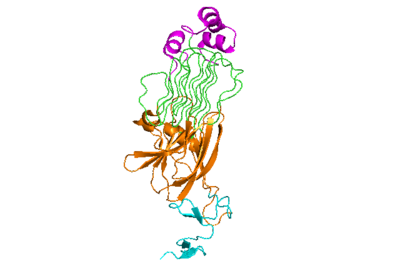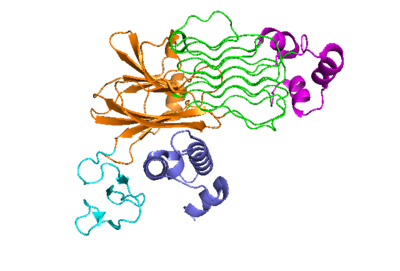Sandbox Reserved 1712
From Proteopedia
(Difference between revisions)
| Line 13: | Line 13: | ||
[[Image:Proteo_ALK-ALKAL_Monomer_White.png|400 px|right|thumb|Figure 3: ALK-ALKAL complex, showing the conformation change of ALK from the binding of ALKAL.]] | [[Image:Proteo_ALK-ALKAL_Monomer_White.png|400 px|right|thumb|Figure 3: ALK-ALKAL complex, showing the conformation change of ALK from the binding of ALKAL.]] | ||
===Conformational Change=== | ===Conformational Change=== | ||
| - | The anaplastic lymphoma kinase activating ligand (ALKAL) binds to the <scene name='90/ | + | The anaplastic lymphoma kinase activating ligand (ALKAL) binds to the <scene name='90/904317/Alk-alkal_binding_surface/1'>binding surface</scene> on the ALK at the TNFL domain. This induces a conformational change which allows for the PXL and the GlyR domains to hinge forward.<ref>DOI: 10.1038/s41586-021-04140-8</ref> (Figure 3) ALK's TNFL has <scene name='90/904317/Binding_surface_with_residues/1'>residues</scene> E978, E974, E859, and Y966 that form salt bridges with R123, R133, R136, R140, and R117 on ALKAL that allow for activation, leading to <scene name='90/904317/Dimer_full_colored/5'>dimerization</scene> of two ALK-ALKAL monomers. |
===Membrane Guidance of ALKAL to ALK=== | ===Membrane Guidance of ALKAL to ALK=== | ||
| - | The negatively charged phosphate groups on the cell membrane interact with a highly conserved positively charged <scene name='90/ | + | The negatively charged phosphate groups on the cell membrane interact with a highly conserved positively charged <scene name='90/904317/Alkalbindingsurfacewmembrane/1'>helix</scene> on ALKAL that faces the membrane. These <scene name='90/904317/Alkal1membraneinteraction/1'>residues that interact with the cell membrane</scene> [https://www.rcsb.org/structure/7MZZ (7MZZ)] guides ALKAL to ALK and correctly positions ALKAL for its binding surface to face ALK's binding surface, which allows for a more favorable interaction. |
===Role of Activated ALK=== | ===Role of Activated ALK=== | ||
Once the ALKAL binds with ALK and dimerizes with another ALK-ALKAL complex, this activated conformation also initiates a conformational change of the intracellular kinase domain of ALK. This causes an autophosphorylation of several tyrosine residues of this domain, activating a signaling cascade with its kinase activity. | Once the ALKAL binds with ALK and dimerizes with another ALK-ALKAL complex, this activated conformation also initiates a conformational change of the intracellular kinase domain of ALK. This causes an autophosphorylation of several tyrosine residues of this domain, activating a signaling cascade with its kinase activity. | ||
Revision as of 18:49, 29 March 2022
| This Sandbox is Reserved from February 28 through September 1, 2022 for use in the course CH462 Biochemistry II taught by R. Jeremy Johnson at the Butler University, Indianapolis, USA. This reservation includes Sandbox Reserved 1700 through Sandbox Reserved 1729. |
To get started:
More help: Help:Editing |
Anaplastic Lymphoma Kinase
| |||||||||||
References
- ↑ Huang H. Anaplastic Lymphoma Kinase (ALK) Receptor Tyrosine Kinase: A Catalytic Receptor with Many Faces. Int J Mol Sci. 2018 Nov 2;19(11). pii: ijms19113448. doi: 10.3390/ijms19113448. PMID:30400214 doi:http://dx.doi.org/10.3390/ijms19113448
- ↑ Murray PB, Lax I, Reshetnyak A, Ligon GF, Lillquist JS, Natoli EJ Jr, Shi X, Folta-Stogniew E, Gunel M, Alvarado D, Schlessinger J. Heparin is an activating ligand of the orphan receptor tyrosine kinase ALK. Sci Signal. 2015 Jan 20;8(360):ra6. doi: 10.1126/scisignal.2005916. PMID:25605972 doi:http://dx.doi.org/10.1126/scisignal.2005916
- ↑ Li T, Stayrook SE, Tsutsui Y, Zhang J, Wang Y, Li H, Proffitt A, Krimmer SG, Ahmed M, Belliveau O, Walker IX, Mudumbi KC, Suzuki Y, Lax I, Alvarado D, Lemmon MA, Schlessinger J, Klein DE. Structural basis for ligand reception by anaplastic lymphoma kinase. Nature. 2021 Dec;600(7887):148-152. doi: 10.1038/s41586-021-04141-7. Epub 2021, Nov 24. PMID:34819665 doi:http://dx.doi.org/10.1038/s41586-021-04141-7
- ↑ Reshetnyak AV, Rossi P, Myasnikov AG, Sowaileh M, Mohanty J, Nourse A, Miller DJ, Lax I, Schlessinger J, Kalodimos CG. Mechanism for the activation of the anaplastic lymphoma kinase receptor. Nature. 2021 Dec;600(7887):153-157. doi: 10.1038/s41586-021-04140-8. Epub 2021, Nov 24. PMID:34819673 doi:http://dx.doi.org/10.1038/s41586-021-04140-8
- ↑ De Munck S, Provost M, Kurikawa M, Omori I, Mukohyama J, Felix J, Bloch Y, Abdel-Wahab O, Bazan JF, Yoshimi A, Savvides SN. Structural basis of cytokine-mediated activation of ALK family receptors. Nature. 2021 Oct 13. pii: 10.1038/s41586-021-03959-5. doi:, 10.1038/s41586-021-03959-5. PMID:34646012 doi:http://dx.doi.org/10.1038/s41586-021-03959-5




